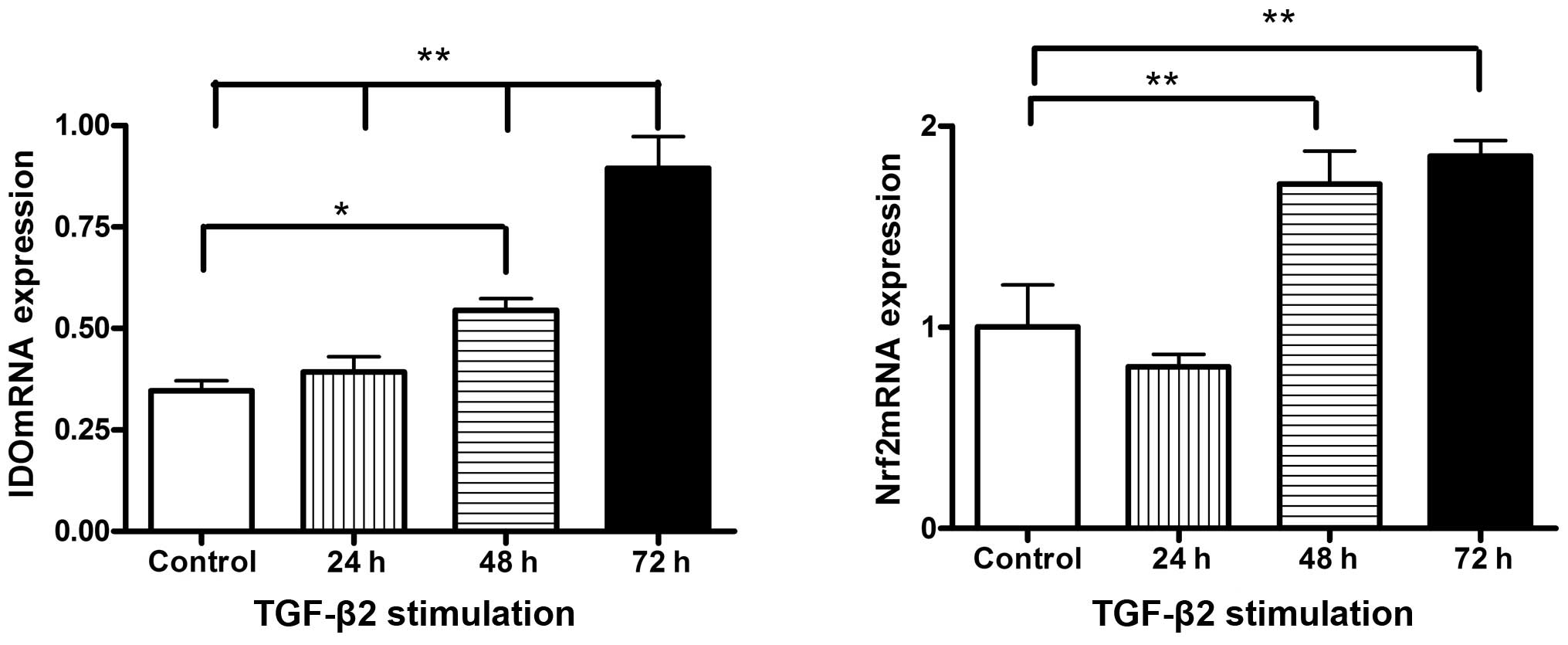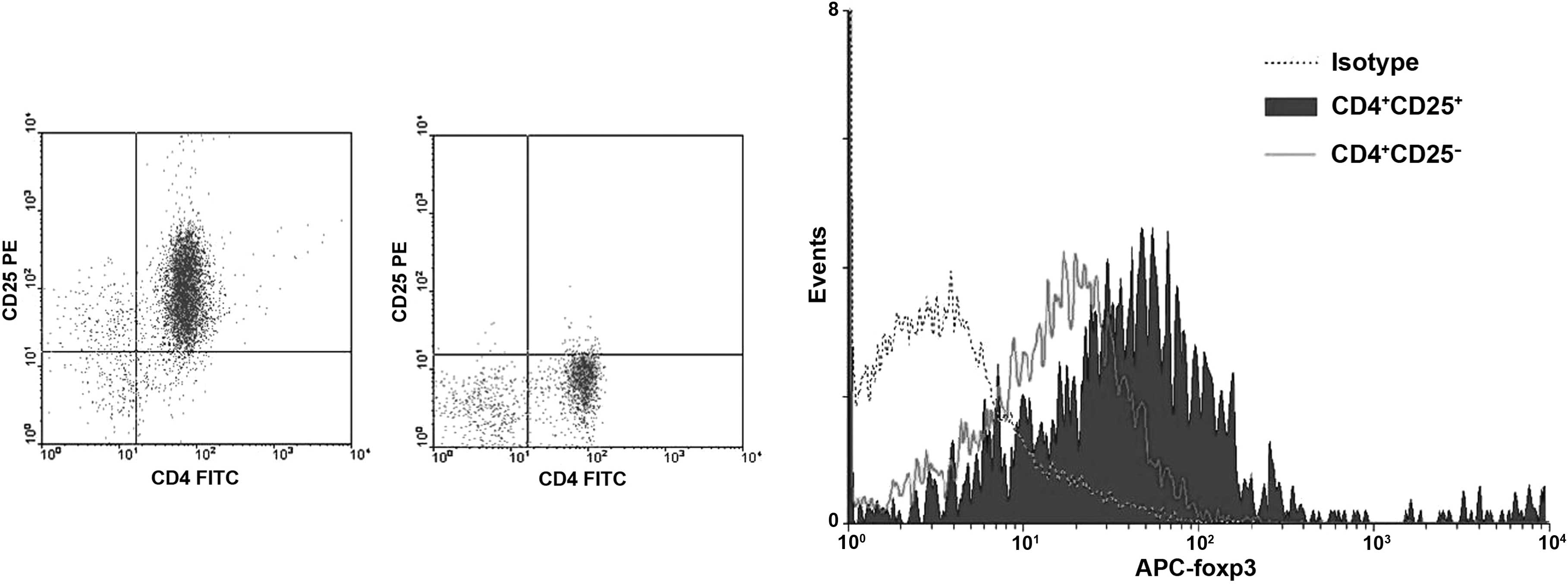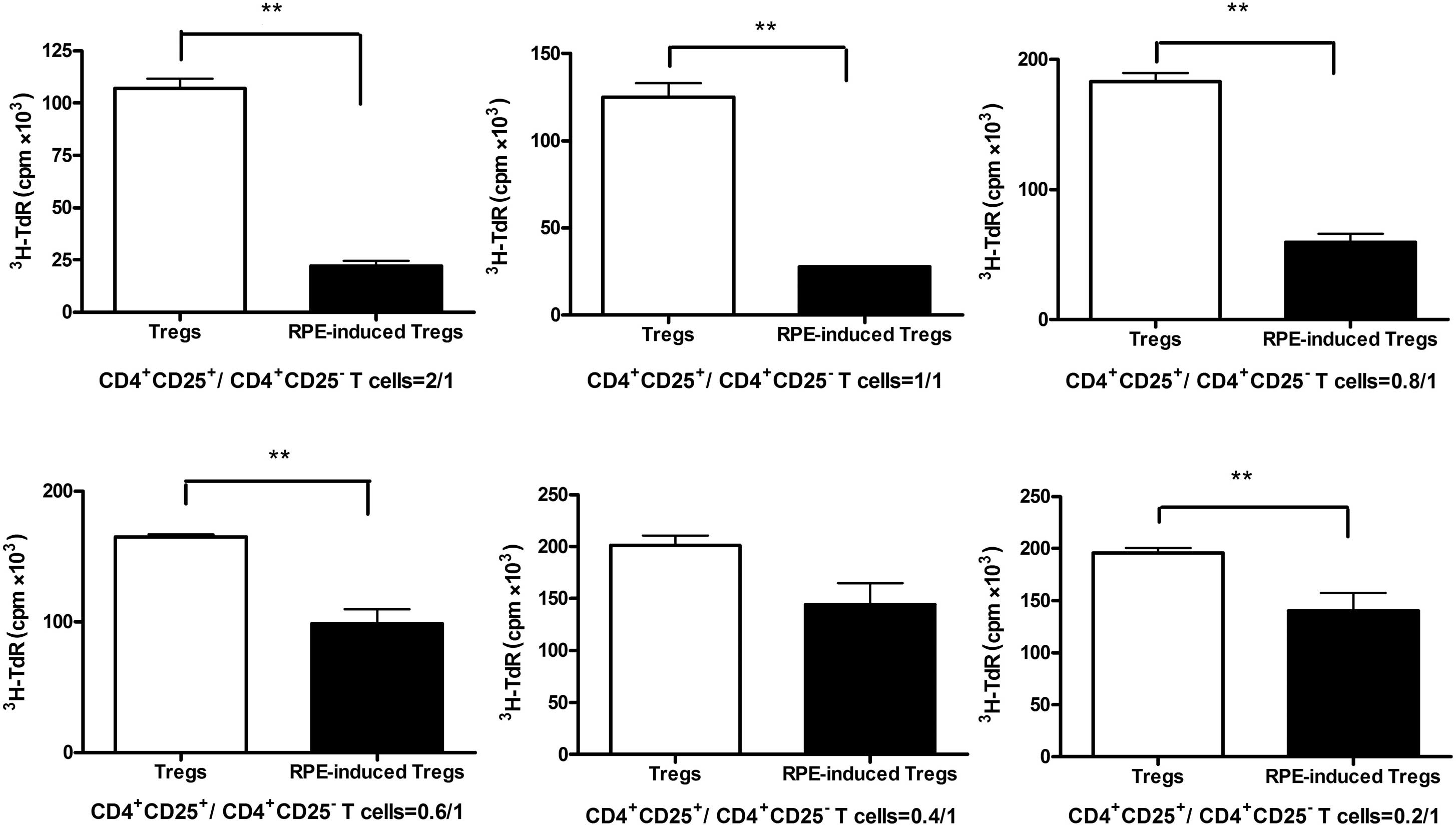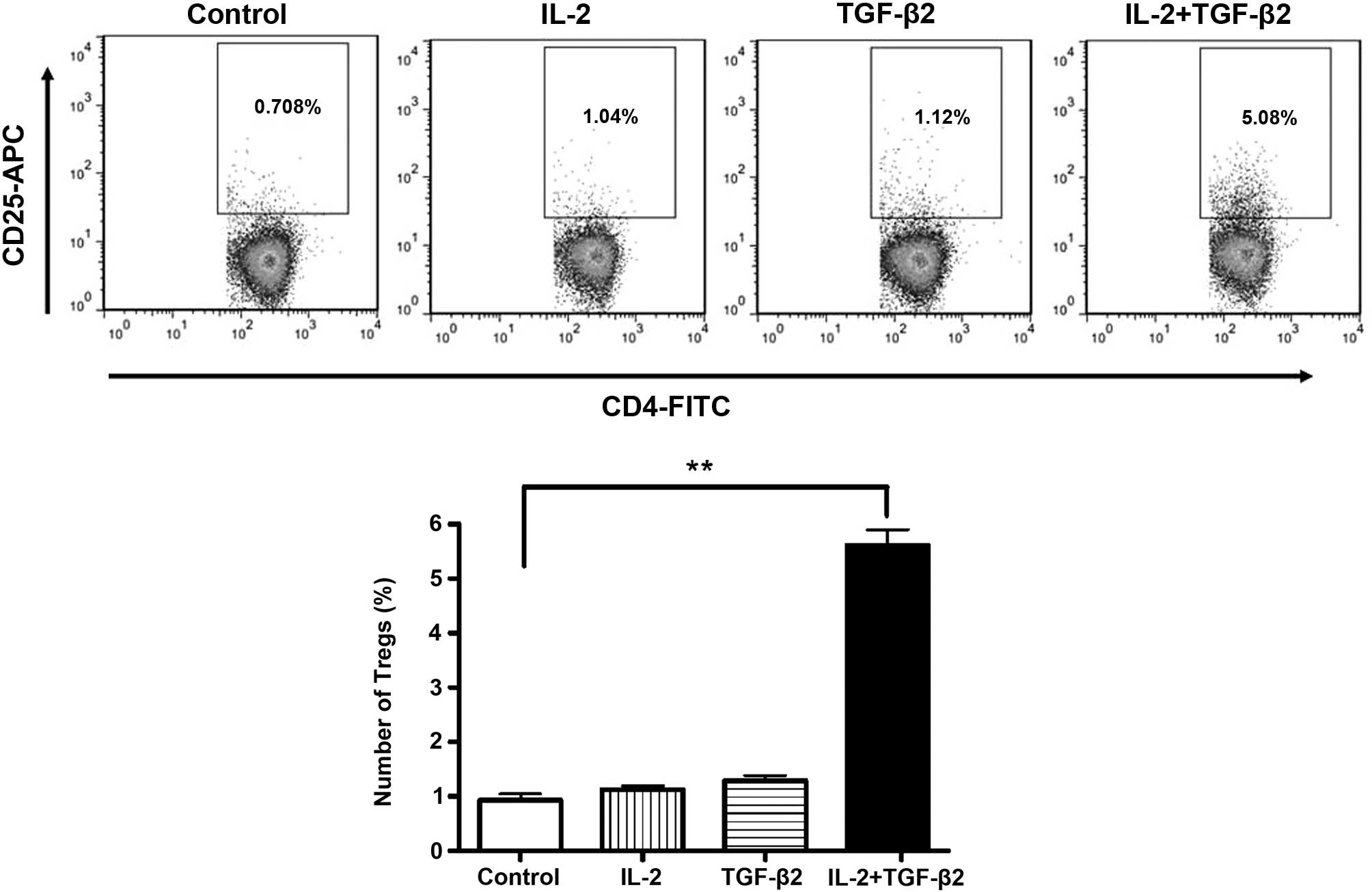Transforming growth factor‑β2 increases the capacity of retinal pigment epithelial cells to induce the generation of regulatory T cells
- Authors:
- Published online on: December 9, 2015 https://doi.org/10.3892/mmr.2015.4666
- Pages: 1367-1372
Abstract
Introduction
Ocular immune privilege exists in the anterior as well as the posterior segment of the eye. Retinal pigment epithelial (RPE) cells are important for the creation and maintenance of ocular immune privilege in the sub-retinal space, which is associated with intraocular suppression of immunogenic inflammation (1,2). Antigens (Ag) presented by non-professional antigen-presenting cells (APCs), major histocompatibility complex (MHC) induced by RPE cells, and various cytokines induced by local inflammation, are able to further promote the induction of Ag-specific peripheral retinal tolerance through interaction with autoreactive, circulating naive T cells, which are not eliminated due to central tolerance. RPE cells with induced expression of MHC class II hare known to be capable of presenting Ag to Ag-experienced CD4+ T cells (3,4). In addition, RPE cells have been shown to secrete soluble factors, including transforming growth factor-β (TGF-β), thrombospondin-1 and prostaglandin E2, which can alter the expression of adaptive as well as innate immune effector mechanisms in vitro (5).
CD25 is the receptor of interleukin (IL)-2. It is widely accepted that the regulatory T cells (Tregs) are CD4+ T cells that co-express CD25 (5–10% of peripheral lymphocytes). Forkhead winged helix transcription factor-3 (Foxp3) is expressed predominantly in Tregs and is necessary as well as sufficient for their development and function; furthermore, Tregs have immunoregulatory abilities by which they prevent organ-specific autoimmune disease (6,7). A number of studies have demonstrated that APCs can induce the generation of Tregs (8–10). However, the process of Treg generation with RPE cells acting as APCs has remained largely elusive. The present study hypothesized that RPE cells act as APCs and induce Treg expansion to suppress inflammation, which may represent a potential treatment strategy for posterior uveitis. The activity of indoleamine 2,3-dioxygenase (IDO) has a tight correlation with the peripheral immune tolerance and immune regulation (11). The activation of the nuclear factor erythroid 2-related factor (Nrf2) pathway is an anti-oxidant response, which confers cellular protection against the detrimental effects of various insults (12). Therefore, the present study hypothesized that TGF-β2 maintains RPE cells in an immunosuppressive condition through IDO regulation or via an anti-oxidant response. Furthermore, the present study investigated the mechanism of the induction of Tregs via CD4+ T cells cultured in vitro in the presence of RPE cells. The immunosuppressive function of natural Tregs was compared to that of RPE-induced Tregs.
Materials and methods
Preparation of human RPE cells and TGF-β2 stimulation
The present study was performed in accordance with the Declaration of Helsinki and was approved by the Institutional Review Board of Jingling Hospital (Nanjing, China). The ARPE-19 human RPE cell line was obtained from the American Type Culture Collection (Manassas, VA, USA). Complete Dulbecco's modified Eagle's medium (DMEM; Thermo Fisher Scientific, Waltham, MA, USA) containing 10% fetal bovine serum (FBS; Thermo Fisher Scientific) was used for the culture of ARPE-19 cells. Cultures were passaged by dissociation in 0.25% trypsin (Thermo Fisher Scientific) in phosphate-buffered saline (PBS; Thermo Fisher Scientific). The cells were maintained for several weeks and the medium was replaced every five days. The supernatants of RPE cells cultured in the presence or absence of recombinant human TGF-β2 (5 ng/ml; R&D Systems, Minneapolis, MN, USA) for 24–72 h were harvested for the generation of Tregs. RPE cells were harvested for RNA isolation and reverse-transcription quantitative polymerase chain reaction (RT-qPCR) analysis of IDO and Nrf2.
RT-qPCR
Cellular extracts were prepared from the cultured RPE cells. The cultured RPE cells were washed twice with PBS, and total RNA was extracted using TRIzol reagent. (Invitrogen; Thermo Fisher Scientific). qPCR was performed as previously described (13). The quantity of the RNA was assessed at an absorbance of 260/280 nm using a NanoDrop 1000 Spectrophotometer (Thermo Fisher Scientific). The RNA (500 ng) was subjected to reverse transcription using Moloney murine leukemia virus reverse transcriptase and oligo(dT) primer (Invitrogen). The paired primers for IDO mRNA were 5′-CAAAGGTCATGGAGATGTCC-3′ (forward) and 5′-CCACCAATAGAGAGACCAGG-3′ (reverse). The paired primers for Nrf2 mRNA were 5′-GAGAGCCCAGTCTTCATTGC-3′ (forward) and 5′-TGCTCAATGTCCTGTTGCAT-3′ (reverse). The thermocycling conditions were as follows: 40 sec at 94°C, 40 sec at 56°C and 40 sec at 72°C for 30 cycles. PCR was performed in an Opticon 2 Real-Time PCR Detection System (Bio-Rad Laboratories, Inc, Hercules, CA, USA) using corresponding primers and SYBR gene PCR Master Mix (Invitrogen). The mRNA expression levels of IDO and Nrf2 were normalized to that of GAPDH, determined with the paired primers 5′-ACAGTCAGCCGCATCTTC-3′ (forward) and 5′-GCCCAATACGACCAAATCC-3′ (reverse). The expression levels of the mRNAs were expressed as fold changes compared with the sham control as determined using the 2−ΔΔCq method (14).
Induction of Tregs with RPE cell culture supernatant
The T cells were separated by magnetic cell sorting (MACS) CD4+ T-cell isolation kits (MACS systems; Miltenyi Biotec GmbH, Bergisch Gladbach, Germany). To avoid contamination with RPE cells, CD4+ T cells (1×106/well) were exposed to RPE cell culture supernatants in the presence of anti-human CD3 antibody (2.0 µg/ml; Clone HIT3a; BD Pharmingen, San Diego, CA, USA) and human recombinant IL-2 (rIL-2; 200 U/ml; R&D Systems) for 72 h in RPMI 1640 containing 10% FBS (Gibco; Thermo Fisher Scientific). In order to investigate the most suitable immune microenvironment for inducing Tregs, CD4+ T cells were exposed to the supernatant of ARPE-19 cells incubated as follows: Untreated (control) or treated with rIL-2 (200 U/ml) or TGF-β2 (5 ng/ml) or with TGF-β2 (5 ng/ml) + rIL-2 (200 U/ml). Following 24 h of incubation, CD4+ T cells exposed to the RPE supernatants on 2.0 µg/ml anti-CD3-coated plates were harvested and X-ray irradiated (2,000 rad) to inhibit cell proliferation. The number of CD4+ CD25+ T cells was analyzed by fluorescence-assisted cell sorting (FACS). CD4+ CD25+ T cells (2×105 cells/well) were then added to the CD4+ CD25− T cells for the subsequent proliferation assay.
FACS analysis
To examine the expression of CD25 on CD4+ T cells in the presence or absence of RPE cell culture supernatants, the T cells were stained with phycoerythrin-conjugated anti-human CD25 (BD Pharmingen) and fluorescein isothiocyanate-conjugated anti-CD4 antibodies (BD Pharmingen). To measure intracellular Foxp3, lymphoid cells were stained to detect cell surface antigens and then fixed with Cytofix/Cytoperm solution (cat. no. 2075KK; BD Pharmingen). Isotype-matched antibodies were used as negative controls. The cells were incubated with monoclonal antibodies (BD Pharmingen) at 4°C for 30 min in the dark and then washed twice in FACS buffer (PBS with 1% bovine serum albumin and 0.1% sodium azide) immediately prior to flow cytometric data acquisition. Samples were acquired using a FACSCalibur flow cytometer (BD Biosciences, Franklin Lakes, NJ, USA) and analyzed using FlowJo 7.6.1 software (Ashland, OT, Canada). Ten thousand cells were analyzed in each sample. The isotype controls were used to establish the gating for positive staining of CD25. The fraction of positive cells among the CD4+ cell population was calculated for each marker.
Cell purification
To generate RPE-induced Tregs, the CD4+ T cells exposed to the supernatants of RPE cells cultured with TGF-β2 and/or rIL-2 and anti-CD3 as stated above were harvested. CD4+ CD25+ T cells were purified by magnetic bead separation using a CD4+ CD25+ T-cell isolation kit (Miltenyi Biotec GmbH). The procedure was performed according to the manufacturer's two-step MACS protocol. CD4+ CD25+ T cells and the unbound fraction, which contained CD4+ CD25− T cells, were collected separately. The purity and phenotypes of the cells were detected by FACS. When the T cells were stained with anti-pancytokeratin antibody (clone PCK-26; Sigma-Aldrich, St. Louis, MO, USA), cytokeratin-positive RPE cells were not detected (≤0.3%) in the harvested Tregs. To generate natural Tregs, dendritic cells (DCs) isolated from peripheral blood mononuclear cells of five healthy volunteers were used as APCs and were prepared by incubating CD4-depleted blood cells with CD11c antibody-coated microbeads (BD Pharmingen) at 4°C for 15 min, followed by positive selection. DCs were then treated with 50 µg/ml mitomycin C (Sigma-Aldrich) for 20 min at 37°C and washed three times.
Proliferation of CD4+ CD25− T cells
To compare the immunosuppressive function of natural Tregs and RPE-induced Tregs, the purified CD4+ CD25− T cells (2×105/well) were cultured alone or with the CD4+ CD25+ T cells (0.4–4×105/well; natural or RPE-induced as described above) and in the presence of 3 µg/ml soluble anti-CD3 and APCs (5×104/well). Cells were cultured in 96-well plates in 200 µl RPMI supplemented with 10% fetal calf serum for three days and pulsed with 1 µCi of [3H]thymidine (3H-TdR; GE Healthcare, Little Chalfont, UK) for an additional 16 h. 3H-TdR incorporation was quantified using a Beckman scintillation counter (Beckman Coulter, Brea, CA, USA). The results are expressed as the mean cpm of triplicate cultures.
Statistical analysis
Values are expressed as the mean ± standard deviation and all experiments were repeated at least twice. The parametric data were analyzed using two-way analysis of variance (Figs. 1 and 3) or the independent samples t-test (Fig. 4). The non-parametric data were analyzed using the Mann-Whitney U test (Fig. 2). P<0.05 was considered to indicate a statistically significant difference.
Results
TGFβ2-induced mRNA upregulation of IDO and Nrf2 in RPE cells
As shown in Fig. 1, RPE cells that were not stimulated by TGF-β2 exhibited a low level of mRNA expression of IDO, an immunoregulatory factor. Of note, IDO was slightly upregulated after RPE cells had been treated with recombinant TGF-β2 for 24 h (P=0.507), significantly increased after 48 h (P=0.019) and highest after 72 h (P<0.001). However, Nrf2 mRNA expression in RPE cells was slightly decreased after treatment with TGF-β2 for 24 h (P=0.349) and significantly increased after 48 h (P=0.008) and 72 h (P=0.003) of TGF-β2 stimulation (Fig. 1).
TGF-β2 enhances RPE cell-induced differentiation of CD4+ CD25+ T cells
To test whether RPE cells are capable of inducing differentiation of CD4+ T cells into CD4+ CD25+ Tregs, a well-established protocol for the generation of Tregs from CD4+ T cells was applied. It has been reported that human RPE cell lines do not convert CD4+ T cells into Tregs (15). However, in the present study, the supernatant of RPE cells treated with TGF-β2 induced differentiation of CD4+ T cells into Tregs in the presence of IL-2 and anti-CD3. The mRNA expression of IDO in the RPE cells was increased during this process. CD4+ T cells that were exposed to rIL-2 and the supernatants of RPE cells treated with TGF-β2 and IL-2 combined expressed a significantly higher level of CD25 than CD4+ T cells exposed to the supernatant of RPE cells cultured with TGF-β2 or IL-2 alone (P<0.001) (Fig. 2).
Phenotype of isolated and purified CD4+ CD25+ Tregs
To further functionally characterize the CD4+ CD25+ T cells induced in the present study, the CD4+ T cells were isolated using MACS microbeads and sorted on the basis of surface CD25 expression. After CD4+ CD25+ T cells were isolated by two-step MACS, 89.78% (range, 86.29–90.04%) of the cells expressed CD4 as well as CD25. To verify the enrichment of Tregs, the CD4+ CD25+/CD4+ CD25− T cells were analyzed for the expression of Foxp3, a Treg-specific transcription factor. Foxp3 was preferentially expressed by CD4+ CD25+ T cells (64.8±1.23%), whereas the CD4+ CD25− sub-population exhibited a low expression level of Foxp3 (15.83±2.74%; P<0.001 for CD4+ CD25+ vs. CD4+ CD25−) (Fig. 3).
RPE-induced Tregs suppress the activation of T cells in vitro
The ability of CD4+ CD25+ T cells to regulate the proliferative response of CD4+ CD25− T cells was measured by mixed lymphocyte reaction (MLR). Marked proliferative responses were observed in vitro when CD4+ CD25− T cells were stimulated with anti-CD3 in the presence of syngeneic APCs, whereas natural Tregs and RPE-induced Tregs showed minimal proliferative responses (data not shown). To compare the ability to suppress CD4+ CD25− T cell proliferation between the natural Tregs and the RPE-induced Tregs, varying numbers of CD4+ CD25+ T cells were added to a constant number of CD4+ CD25− T cells and activated in vitro with anti-CD3. As shown in Fig. 4, although the natural CD4+ CD25+ T cells inhibited the proliferation of CD4+ CD25− T cells, RPE-induced CD4+ CD25+ T cells were more effective at suppressing the proliferation of CD4+ CD25− T cells (P<0.01) with ~75% suppression of proliferation at a higher cell density (CD4+ CD25+/CD4+ CD25− T cells, 2:1).
Discussion
Immunologically, RPE cells have a pivotal role in immune responses (1,3). RPE cells express Toll-like receptors, complement components and Fc-γ receptors; furthermore, they respond to treatment with certain cytokines, upregulate the expression of both MHC class I and II molecules and participate as resident APCs in the retina. Retinal as well as non-retinal Ag can be processed and presented by RPE cells (3,16). IDO is an enzyme that catabolizes the essential amino acid tryptophan into the stable metabolite kynurenine. IDO activity has been found to greatly impact peripheral tolerance and immune regulation (11). It is thought that IDO is a signaling protein in long-term tolerance by DCs (17,18). TGF-β is known to induce IDO expression in DCs. It is possible that a TGF-β/IDO/tryptophan metabolite axis is involved in the maintenance of an immunosuppressive environment (19). Park et al (20) reported that the immunosuppressive enzyme IDO is highly expressed in RPE cells under interferon-γ (IFN-γ) stimulation and that IDO may have a significant role in RPE cell-mediated immune suppression and ocular immune privilege. In normal eyes, TGF-β2 is constitutively present and actively participates in the maintenance of ocular immune privilege. It has been proven that the increased expression of cytotoxic T lymphocyte-associated Ag-2 alpha in RPE cells induces Tregs through the increased production of TGF-β (5,21). Therefore, TGF-β2 was used as a stimulator in the present study and led to the upregulation of IDO mRNA expression in RPE cells following 48–72 h of incubation. However, the mRNA expression of Nrf2 in RPE cells was slightly decreased after TGF-β2 stimulation for 24 h, followed by marked increases following 48 and 72 h of stimulation. The Nrf2 pathway is involved in cell survival signaling in response to oxidants and other insults and confers cellular protection (12). Therefore, the results of the present study suggested that TGF-β2 maintained RPE cells in an immunosuppressive condition through IDO regulation, which was possibly followed by an Nrf2-mediated anti-oxidant response. The immunosuppressive enzyme IDO may have a significant role in RPE cell-mediated immune suppression and ocular immune privilege. Ocular immune privilege is a complex phenomenon which has remained largely elusive; however, IDO may represent an important modulator. The expression of IDO observed in the present study may, at least in part, explain for the RPE-mediated immunosuppressive effects and the role of the RPE in ocular responses to immune, infectious and inflammatory diseases.
CD4+ CD25+ Tregs are a unique population of Tregs that maintain peripheral immune tolerance. Naturally occurring Tregs constitute only 1–5% of total CD4+ T cells in human peripheral blood. A large number of Tregs may be required for an effective Treg-based cellular immunotherapy. Several approaches have been used for the generation and expansion of Ag-specific human Tregs (22,23). Hippen et al (24) reported that CD4+ CD25+ Tregs can be expanded 3,000-fold by culture in the presence of IL-2, rapamycin and artificial human APCs. With the goal of producing homogeneous Tregs, Okubo et al (23) developed a novel expansion protocol targeting tumor necrosis factor receptors on Tregs. Golshayan et al (9) used autologous DCs as APCs to select and expand Ag-specific CD4+ CD25+ T-cell lines from freshly isolated polyclonal CD4+ CD25+ Tregs in vitro, and these Ag-specific CD4+ CD25+ T cells maintained their phenotypic characteristics and acquired potent Ag-specific suppressive activity. It has been indicated that ex vivo-generated inducible Tregs are significantly more potent than natural Tregs with regard to immunosuppressive modulation (9,25). The present study demonstrated that the supernatant of RPE cells pre-treated with TGF-β2 and IL-2 enhanced the differentiation of CD4+ T cells into CD4+ CD25+ Tregs. Furthermore, RPE-induced Tregs suppressed the proliferation of CD4+ CD25− T cells more effectively than natural Tregs and achieved a ~75% suppression of CD4+ CD25− T-cell proliferation at a high CD4+ CD25+/CD4+ CD25− T-cell ratio. These results indicated that TGF-β2 induced RPE cells to expand Tregs. As it was observed that TGF-β2 induced IDO expression in RPE cells, it may be hypothesized that IDO is a signaling protein in RPE cells for the induction of Tregs, which should be verified in further studies. This mechanism may have an immunosuppressive role and the resulting RPE-induced Tregs may be applied as potential immunotherapeutics for ocular inflammatory diseases, including posterior uveitis or graft rejection of RPE-cell transplantation (2). Achieving stable RPE-induced Tregs in the eye is the key for future immunotherapy.
Intraocular migratory T cells from the choroid vessels must pass through the RPE layer to reach the retinal space. The present study hypothesized that intraocular effector T cells can be converted into immunosuppressive CD4+ CD25+ Tregs in the sub-retinal space by cell-cell contact and the cytokines produced upon their interaction with RPE cells. Further study is required to understand the complexity of the immune modulatory roles of RPE cells. The present study demonstrated the role of RPE cells as a significant immune modulatory factor contributing to ocular immune privilege. Thus, it demonstrated that RPE-induced Tregs suppress the proliferation of alloreactive T cells in vitro, while the in vivo immune suppression achieved through RPE-induced Tregs need warrants further investigation.
Acknowledgments
The present study was supported by the Postdoc Foundation of Jiangsu Province of China (no. 0702040C). This manuscript has been edited and proofread by Medjaden Bioscience Ltd. (Hong Kong, China).
Abbreviations:
|
Tregs |
regulatory T cells |
|
RPE |
retinal pigment epithelial |
|
TGF-β2 |
transforming growth factor-β 2 |
|
IDO |
indoleamine 2,3-dioxygenase |
|
Nrf2 |
nuclear factor erythroid 2-related factor |
|
MACS |
magnetic cell sorting |
|
rIL-2 |
recombinant interleukin-2 |
|
APCs |
antigen-presenting cells |
References
|
Sugita S: Role of ocular pigment epithelial cells in immune privilege. Arch Immunol Ther Exp (Warsz). 57:263–268. 2009. View Article : Google Scholar | |
|
Imai A, Sugita S, Kawazoe Y, Horie S, Yamada Y, Keino H, Maruyama K and Mochizuki M: Immunosuppressive properties of regulatory T cells generated by incubation of peripheral blood mononuclear cells with supernatants of human RPE cells. Invest Ophthalmol Vis Sci. 53:7299–7309. 2012. View Article : Google Scholar : PubMed/NCBI | |
|
Detrick B and Hooks JJ: Immune regulation in the retina. Immunol Res. 47:153–161. 2010. View Article : Google Scholar : PubMed/NCBI | |
|
Gregerson DS, Heuss ND, Lew KL, McPherson SW and Ferrington DA: Interaction of retinal pigmented epithelial cells and CD4 T cells leads to T-cell anergy. Invest Ophthalmol Vis Sci. 48:4654–4663. 2007. View Article : Google Scholar : PubMed/NCBI | |
|
Sugita S, Horie S, Nakamura O, Futagami Y, Takase H, Keino H, Aburatani H, Katunuma N, Ishidoh K, Yamamoto Y and Mochizuki M: Retinal pigment epithelium-derived CTLA-2alpha induces TGFbeta-producing T regulatory cells. J Immunol. 181:7525–7536. 2008. View Article : Google Scholar : PubMed/NCBI | |
|
Sakaguchi S, Sakaguchi N, Asano M, Itoh M and Toda M: Immunologic self-tolerance maintained by activated T cells expressing IL-2 receptor alpha-chains (CD25). Breakdown of a single mechanism of self-tolerance causes various autoimmune diseases. J Immunol. 155:1151–1164. 1995.PubMed/NCBI | |
|
Sakaguchi S: Naturally arising Foxp3-expressing CD25+CD4+ regulatory T cells in immunological tolerance to self and non-self. Nat Immunol. 6:345–352. 2005. View Article : Google Scholar : PubMed/NCBI | |
|
Yamazaki S and Morita A: Dendritic cells in the periphery control antigen-specific natural and induced regulatory T cells. Front Immunol. 4:1512013. View Article : Google Scholar : PubMed/NCBI | |
|
Golshayan D, Jiang S, Tsang J, Garin MI, Mottet C and Lechler RI: In vitro-expanded donor alloantigen-specific CD4+CD25+ regulatory T cells promote experimental transplantation tolerance. Blood. 109:827–835. 2007. View Article : Google Scholar | |
|
Yamazaki S, Inaba K, Tarbell KV and Steinman RM: Dendritic cells expand antigen-specific Foxp3+ CD25+ CD4+ regulatory T cells including suppressors of alloreactivity. Immunol Rev. 212:314–329. 2006. View Article : Google Scholar : PubMed/NCBI | |
|
Singer-Sam J, Robinson MO, Bellvé AR, Simon MI and Riggs AD: Measurement by quantitative PCR of changes in HPRT, PGK-1, PGK-2, APRT, MTase and Zfy gene transcripts during mouse spermatogenesis. Nucleic Acids Res. 18:1255–1259. 1990. View Article : Google Scholar : PubMed/NCBI | |
|
Horie S, Sugita S, Futagami Y, Yamada Y and Mochizuki M: Human retinal pigment epithelium-induced CD4+CD25+ regulatory T cells suppress activation of intraocular effector T cells. Clin Immunol. 136:83–95. 2010. View Article : Google Scholar : PubMed/NCBI | |
|
Bodaghi B, Goureau O, Zipeto D, Laurent L, Virelizier JL and Michelson S: Role of IFN-gamma-induced indoleamine 2,3 dioxygenase and inducible nitric oxide synthase in the replication of human cytomegalovirus in retinal pigment epithelial cells. J Immunol. 162:957–964. 1999.PubMed/NCBI | |
|
Livak KJ and Schmittgen TD: Analysis of relative gene expression data using real-time quantitative PCR and the 2(-Delta Delta C(T)) Method. Methods. 25:402–408. 2001. View Article : Google Scholar | |
|
Grohmann U, Fallarino F and Puccetti P: Tolerance: DCs and tryptophan: Much ado about IDO. Trends Immunol. 24:242–248. 2003. View Article : Google Scholar : PubMed/NCBI | |
|
Chen W: IDO: More than an enzyme. Nat Immunol. 12:809–811. 2011. View Article : Google Scholar : PubMed/NCBI | |
|
Harden JL and Egilmez NK: Indoleamine 2,3-dioxygenase and dendritic cell tolerogenicity. Immunol Invest. 41:738–764. 2012. View Article : Google Scholar : PubMed/NCBI | |
|
Pallotta MT, Orabona C, Volpi C, Vacca C, Belladonna ML, Bianchi R, Servillo G, Brunacci C, Calvitti M, Bicciato S, et al: Indoleamine 2,3-dioxygenase is a signaling protein in long-term tolerance by dendritic cells. Nat Immunol. 12:870–878. 2011. View Article : Google Scholar : PubMed/NCBI | |
|
Cousins SW, McCabe MM, Danielpour D and Streilein JW: Identification of transforming growth factor-beta as an immunosuppressive factor in aqueous humor. Invest Ophthalmol Vis Sci. 32:2201–2211. 1991.PubMed/NCBI | |
|
Park CY, Yang SH, Chuck RS, Gehlbach PL and Park CG: The role of indoleamine 2,3-dioxygenase in retinal pigment epithelial cell-mediated immune modulation. Ocul Immunol Inflamm. 18:24–31. 2010. View Article : Google Scholar : PubMed/NCBI | |
|
Chan K, Han XD and Kan YW: An important function of Nrf2 in combating oxidative stress: Detoxification of acetaminophen. Proc Natl Acad Sci USA. 98:4611–4616. 2001. View Article : Google Scholar : PubMed/NCBI | |
|
Wang X, Lu L and Jiang S: Regulatory T cells: Customizing for the clinic. Sci Transl Med. 3:83ps192011. View Article : Google Scholar : PubMed/NCBI | |
|
Okubo Y, Mera T, Wang L and Faustman DL: Homogeneous expansion of human T-regulatory cells via tumor necrosis factor receptor 2. Sci Rep. 3:31532013. View Article : Google Scholar : PubMed/NCBI | |
|
Hippen KL, Merkel SC, Schirm DK, Sieben CM, Sumstad D, Kadidlo DM, McKenna DH, Bromberg JS, Levine BL, Riley JL, et al: Massive ex vivo expansion of human natural regulatory T cells [T(regs)] with minimal loss of in vivo functional activity. Sci Transl Med. 3:83ra412011. View Article : Google Scholar | |
|
Karlsson F, Martinez NE, Gray L, Zhang S, Tsunoda I and Grisham MB: Therapeutic evaluation of ex vivo-generated versus natural regulatory T-cells in a mouse model of chronic gut inflammation. Inflamm Bowel Dis. 19:2282–2294. 2013. View Article : Google Scholar : PubMed/NCBI |













